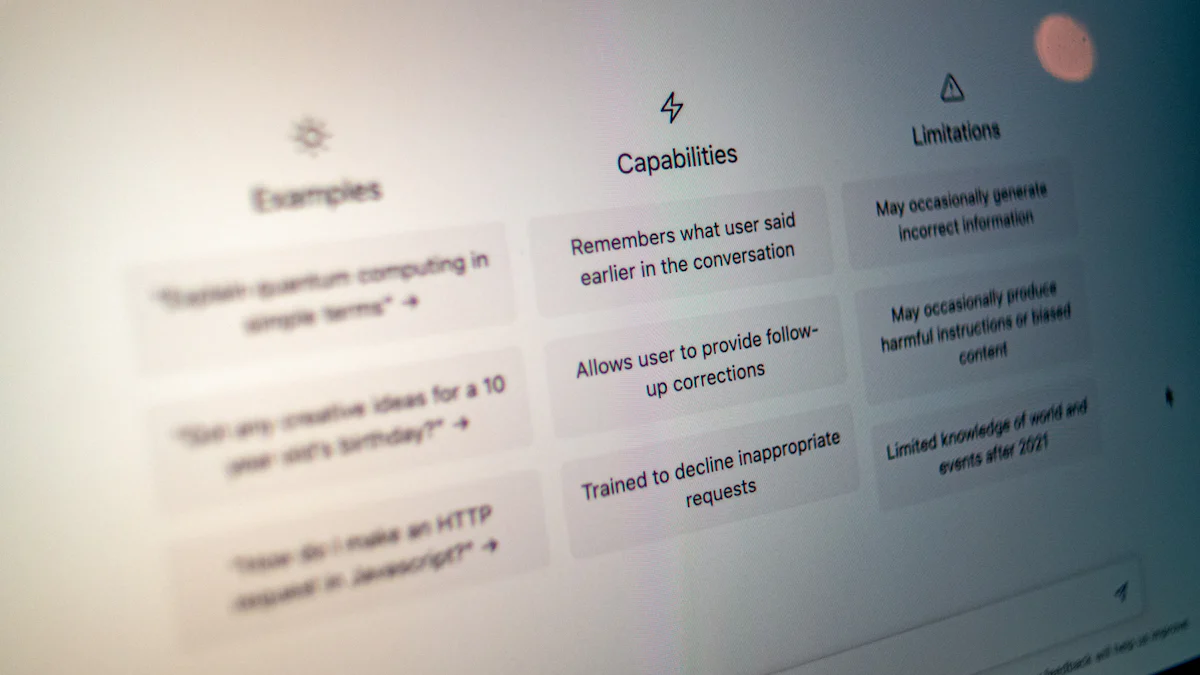How AI Hiring Software Crafts Predictive Models

AI Hiring Software revolutionizes the recruitment process by crafting predictive models that enhance hiring decisions. You benefit from its ability to analyze vast amounts of data, identifying patterns that lead to successful hires. Machine learning plays a crucial role, allowing the software to learn and adapt over time. This adaptability results in a 46% increase in successful hires, as noted by a Harvard Business Review study. Moreover, AI's efficiency speeds up the hiring process, with 86.1% of recruiters confirming its time-saving capabilities. By leveraging AI, you can achieve greater accuracy and efficiency in your hiring practices.
Data Collection and Preprocessing

In the realm of AI Hiring Software, data collection and preprocessing form the backbone of crafting effective predictive models. You need to gather and prepare data meticulously to ensure the accuracy and reliability of the predictions.
Sources of Data
Data sources play a crucial role in building robust predictive models. You can categorize these sources into two main types:
Internal Data Sources
Internal data sources include information from within your organization. This data often comes from your applicant tracking systems (ATS), employee performance records, and historical hiring data. By leveraging internal data, you can gain insights into past hiring successes and failures. For instance, AI recruiting software like hireEZ can search through internal databases to identify potential candidates who match the criteria of successful past hires.
External Data Sources
External data sources provide a broader perspective. These include job boards, social media profiles, and professional networking sites like LinkedIn. AI recruiting platforms analyze these sources to understand candidates' skills, experiences, and qualifications. By tapping into external data, you can expand your candidate pool and find individuals who might not have applied directly to your organization.
Data Cleaning and Preparation
Once you've collected data, the next step is to clean and prepare it for analysis. This process ensures that the data is accurate and ready for model training.
Handling Missing Data
Missing data can skew your results and lead to inaccurate predictions. You must address this issue by either filling in missing values with estimates or removing incomplete records. AI-driven hiring applications often include tools to automate this process, ensuring that your data remains consistent and reliable.
Data Normalization Techniques
Data normalization is essential for maintaining uniformity across different data sets. By applying normalization techniques, you can ensure that all data points are on a comparable scale. This step is crucial for AI-powered recruitment tools, which rely on consistent data to make accurate predictions. Normalization helps in aligning data from various sources, making it easier for the AI models to process and analyze.
By focusing on these aspects of data collection and preprocessing, you can enhance the effectiveness of your AI Hiring Software. Properly prepared data lays the foundation for building predictive models that improve hiring decisions and streamline recruitment processes.
Feature Selection
In AI Hiring Software, feature selection is a critical step that determines the success of predictive models. By identifying and selecting the right attributes, you can enhance the accuracy of your hiring predictions.
Identifying Key Attributes
To build effective predictive models, you must identify key attributes that influence hiring outcomes.
Importance of Job-Specific Features
Job-specific features are essential in predicting a candidate's success in a particular role. These features include technical skills, educational background, and relevant work experience. By focusing on these attributes, you can tailor your hiring process to meet the specific needs of each position. For example, a software developer role might prioritize coding skills and project experience, while a marketing position might emphasize creativity and communication skills.
Role of Soft Skills in Prediction
Soft skills play a significant role in predicting a candidate's potential for success. Attributes such as teamwork, adaptability, and problem-solving abilities are crucial in many roles. AI Hiring Software can analyze these soft skills by evaluating candidate responses and interactions during the recruitment process. By incorporating soft skills into your predictive models, you can gain a more comprehensive understanding of a candidate's suitability for a role.
Techniques for Feature Selection
Selecting the right features requires a combination of statistical methods and machine learning approaches.
Statistical Methods
Statistical methods help you identify the most relevant features by analyzing data patterns and correlations. Techniques such as correlation analysis and regression models can highlight which attributes have the most significant impact on hiring outcomes. By using these methods, you can ensure that your predictive models focus on the most influential factors.
Machine Learning Approaches
Machine learning approaches offer advanced techniques for feature selection. Algorithms like decision trees and random forests can automatically identify and rank features based on their importance. These methods allow you to leverage the power of AI to refine your feature selection process. By using machine learning, you can continuously improve your models as new data becomes available.
By focusing on feature selection, you can enhance the predictive capabilities of your AI Hiring Software. Identifying key attributes and employing effective techniques ensures that your models are accurate and reliable, leading to better hiring decisions.
Model Training
In AI Hiring Software, model training is a pivotal phase that determines the effectiveness of predictive models. You must carefully select algorithms and train them with precision to ensure accurate hiring predictions.
Choosing the Right Algorithm
Selecting the appropriate algorithm is crucial for building robust predictive models. You have two main categories to consider:
Supervised Learning Algorithms
Supervised learning algorithms require labeled data to learn from. You provide these algorithms with input-output pairs, allowing them to understand the relationship between candidate attributes and hiring outcomes. Common supervised learning algorithms include decision trees, support vector machines, and neural networks. These algorithms excel in scenarios where you have historical data with known outcomes, enabling them to make precise predictions about future candidates.
Unsupervised Learning Algorithms
Unsupervised learning algorithms, on the other hand, do not rely on labeled data. They identify patterns and structures within the data without predefined outcomes. Clustering and association algorithms are popular choices in this category. You can use unsupervised learning to uncover hidden patterns in candidate data, such as grouping candidates with similar skills or experiences. This approach is valuable when exploring new insights or identifying potential candidate segments.
Training the Model
Once you've chosen the right algorithm, the next step is to train the model effectively. This process involves several key components:
Training Data Sets
The quality of your training data sets significantly impacts the model's performance. You must ensure that your data is diverse and representative of the candidate pool. As noted by experts, biased data can lead to biased predictions, perpetuating inequalities in hiring outcomes. Therefore, it's essential to use comprehensive data sets that reflect a wide range of candidate attributes and backgrounds. By doing so, you can mitigate bias and enhance the fairness of your AI Hiring Software.
Iterative Training Process
Training a model is not a one-time task. You need to adopt an iterative training process to refine and improve the model over time. This involves continuously feeding new data into the model and adjusting its parameters based on performance feedback. By iterating on the training process, you can enhance the model's accuracy and adaptability. This approach allows the AI to learn from new hiring trends and candidate behaviors, ensuring that your predictive models remain relevant and effective.
By focusing on these aspects of model training, you can harness the full potential of AI Hiring Software. Choosing the right algorithms and employing a rigorous training process ensures that your predictive models deliver accurate and unbiased hiring recommendations.
Model Validation
Model validation is a crucial step in ensuring the effectiveness of your predictive models in AI Hiring Software. By evaluating and testing your models, you can confirm their accuracy and reliability in making hiring decisions.
Evaluation Metrics
To assess the performance of your predictive models, you need to use specific evaluation metrics. These metrics help you understand how well your model predicts hiring outcomes.
Accuracy and Precision
Accuracy measures the proportion of correct predictions out of all predictions made by the model. It gives you a general sense of how often the model is right. However, accuracy alone might not be sufficient, especially in cases where the data is imbalanced. Precision, on the other hand, focuses on the quality of positive predictions. It tells you how many of the predicted positive outcomes are actually correct. High precision means that when the model predicts a candidate as suitable, it is likely correct.
Recall and F1 Score
Recall, also known as sensitivity, measures the model's ability to identify all relevant instances. It shows how well the model captures true positive cases. In hiring, this means identifying all suitable candidates. The F1 Score is the harmonic mean of precision and recall. It provides a balance between the two, especially useful when dealing with imbalanced data. The F1 Score helps you understand the trade-off between precision and recall, ensuring that your model performs well across different scenarios.
Testing the Model
Testing your model involves using various techniques to ensure its robustness and applicability in real-world situations.
Cross-Validation Techniques
Cross-validation is a technique used to evaluate the model's performance by dividing the data into subsets. You train the model on some subsets and test it on others. This process helps you understand how the model will perform on unseen data. Techniques like k-fold cross-validation provide a comprehensive assessment by rotating the training and testing sets, ensuring that every data point gets a chance to be in the test set.
Real-World Testing Scenarios
Real-world testing involves applying the model to actual hiring scenarios to see how it performs. You can simulate hiring processes or use historical data to validate the model's predictions. This step is crucial for understanding how the model behaves in practical situations. By testing in real-world scenarios, you can identify any potential issues and make necessary adjustments to improve the model's accuracy and reliability.
By focusing on model validation, you ensure that your AI Hiring Software delivers reliable and accurate predictions. Using appropriate evaluation metrics and testing techniques, you can refine your models to enhance hiring decisions and achieve better outcomes.
Deployment of Predictive Models
Deploying predictive models in AI Hiring Software involves integrating these models into your existing hiring platforms and ensuring they remain effective over time. This process enhances your recruitment strategy by providing seamless and efficient hiring solutions.
Integration with Hiring Platforms
Integrating predictive models with your hiring platforms is crucial for maximizing their potential. This integration allows you to streamline your recruitment process and improve decision-making.
API and Software Integration
You can achieve seamless integration through APIs and software solutions. APIs enable different software systems to communicate and share data effortlessly. By integrating AI-powered recruitment software with your existing systems, you can automate time-consuming tasks like resume evaluation and candidate screening. This automation not only speeds up the hiring process but also reduces costs by eliminating manual efforts.
User Interface Considerations
A user-friendly interface is essential for effective integration. You should ensure that the AI tools are easy to navigate and understand. A well-designed interface enhances the user experience, making it easier for recruiters to access and utilize the predictive models. This ease of use boosts candidate engagement and helps you connect with the most qualified talent.
Monitoring and Updating Models
Once deployed, continuous monitoring and updating of predictive models are vital to maintain their accuracy and relevance. This ongoing process ensures that your AI Hiring Software adapts to changing hiring trends and candidate behaviors.
Continuous Improvement
You should focus on continuous improvement by regularly assessing the performance of your predictive models. This involves analyzing their predictions and making necessary adjustments to enhance their accuracy. By doing so, you can refine your sourcing strategies and improve the overall hiring experience.
Handling Model Drift
Model drift occurs when a model's performance degrades over time due to changes in data patterns. To handle model drift, you need to update your models with new data and retrain them periodically. This proactive approach ensures that your AI Hiring Software remains effective and continues to provide valuable insights for your recruitment process.
By effectively deploying predictive models, you can optimize your hiring strategy and achieve better outcomes. Integration with hiring platforms and continuous monitoring are key to leveraging the full potential of AI in recruitment.
Ethical Considerations in AI Hiring

Incorporating AI into hiring processes brings significant ethical challenges. You must address these to ensure fairness and inclusivity in recruitment.
Bias and Fairness
AI systems can inadvertently perpetuate biases present in their training data. This can lead to unfair hiring practices, excluding underrepresented groups and exacerbating diversity issues.
Identifying Bias in Data
To promote fairness, you need to identify biases in your data. Historical data often carries biases related to gender, race, age, or ability. These biases can influence AI algorithms, leading to discriminatory outcomes. By conducting bias audits and using diverse training data, you can mitigate these biases. This proactive approach helps ensure that your AI hiring tools promote diversity and inclusivity.
Ensuring Fairness in Predictions
Ensuring fairness in AI predictions requires continuous monitoring and adjustment. You should implement best practices like regular bias detection and updates to your models. This involves analyzing the outcomes of AI predictions and making necessary adjustments to enhance fairness. By doing so, you can create a more equitable hiring process that values all candidates equally.
Transparency and Accountability
Transparency and accountability are crucial in AI hiring. You must ensure that AI decisions are explainable and comply with legal and ethical standards.
Explainability of AI Decisions
Explainability refers to the ability to understand how AI makes decisions. You should strive to make AI decisions transparent, allowing candidates and recruiters to understand the reasoning behind them. This transparency builds trust and ensures that AI complements human judgment in recruitment processes. By providing clear explanations, you can enhance candidate engagement and promote a fair hiring experience.
Legal and Ethical Compliance
Adhering to legal and ethical standards is essential when using AI in hiring. You must stay informed about responsible AI regulations and ensure compliance. This involves understanding the ethical implications of AI systems and implementing measures to address potential issues. By doing so, you can create a hiring process that respects privacy and promotes ethical decision-making.
By addressing these ethical considerations, you can harness the power of AI in hiring while promoting fairness and inclusivity. Identifying biases, ensuring transparency, and adhering to ethical standards are key to creating a responsible and effective recruitment strategy.
AI Hiring Software revolutionizes recruitment by crafting predictive models that enhance decision-making and efficiency. You benefit from its ability to automate time-consuming tasks, streamline processes, and reduce costs. AI provides a data-driven approach, ensuring fair and unbiased candidate evaluations. It identifies unconscious biases, fostering a more equitable hiring landscape. However, ethical considerations remain crucial. You must address potential biases in data and ensure transparency in AI decisions. By doing so, you can harness AI's full potential, creating a more efficient and fair hiring process.
See Also
Harnessing AI Tools to Forecast Candidate Performance
Revolutionizing Recruitment Efficiency with AI Software Solutions
AI Hiring Tools Offering Smart Interview Strategies
Elevate Your Recruitment Strategy Using MokaHR's AI Solutions
From recruiting candidates to onboarding new team members, MokaHR gives your company everything you need to be great at hiring.
Subscribe for more information

